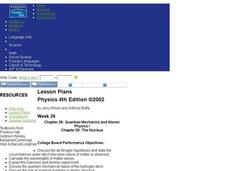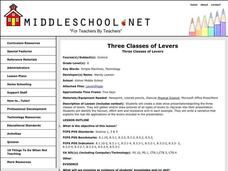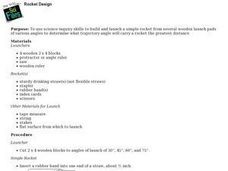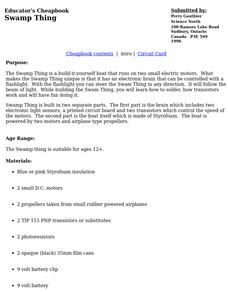Curated OER
Causes and Effects of Earthquakes and Volcanoes
Tenth graders discuss the techniques and tools scientists use to study about the earth, including techniques used to determine geological time scales. They share their personal experiences of earthquakes and volcanoes.
Curated OER
Atmospheric Pressure
Ninth graders explore the abstract idea of the atom and explain the differences and similarities between solids, liquids, and gases. They understand the molecular differences between solids, liquids, and gases.
Curated OER
Visit to the Local Weather Station
Students understand the preparation involved everyday to present the day's forecast and how the instruments are used to create an overall model for predicting weather. They will understanding of the terminology and symbols used in...
Curated OER
Down the Drain
Students examine the following concepts: If water supplies contain materials which rot or decompose, oxygen is used. Decay and decomposition require vast supplies of oxygen. The use of oxygen for decay of wastes may be a life or death...
Curated OER
Causal Patterns in Air Pressure Phenomena
Learners explore a scientific concept to obtain understanding by performing an experiment. The inquiry can be done in groups or as a whole class. The outcome is that students can use models to obtain futher understanding.
Curated OER
Causal Patterns in Air Pressure Phenomena
Students explore the concept of how air moves and reflect through working in groups about the scientific concept. This instructional activity is an extension to another similar instructional activity. Also students develop and draw their...
Curated OER
Relational Causality
Learners explore the concept of Bernoullii's Principle and how it behaves. Have each student fold the piece of paper in half. Then have them place the paper like a tent on a smooth surface. Have them blow under it (they can use a straw...
Curated OER
Heating Ice
Learners explore through inquiry what it is like to heat ice and the results that can be observed. There is a graph that is created to keep track of data. There are questions that are answered to promote the use of the scientific method.
Curated OER
Is Shep Sherman Innocent or Guilty?
Students engage in this activity to use knowledge acquired in this unit to predict the outcome of the trial in Science Court. The students will then publish their predictions on Microsoft Word.
Curated OER
Forces Cause Change
Third graders will gain recognition that physical relationships affect each other and that change occurs when one object acts upon another.The teacher will recognize ways in which technology can be used to enhance the understanding of...
Curated OER
Pendulum Motion Experiments
Students experiment with simple pendulums to determine the validity of an equation for all angles. Students discover the usefulnes and limitations of approximations in science. Using spreadhseets and a java applet, students observe the...
Curated OER
Quantum Mechanics and Atomic Physics
Students will discuss the de Brogile Hypothesis and state the circumstances under which the wave nature of matter is observed. They will also calculate the wavelengths of matter waves.
Curated OER
Forces on the Human Molecule
Young scholars conduct several simple lab activities to explore the five fundamental load types that can act on structures: tension, compression, shear, bending, and torsion. In this activity, students play the role of molecules in a...
Curated OER
Lincoln's Secret Weapon
Students explore how principles of gas behavior relate to diving in order to plan safe underwater activities.
Curated OER
How Things Fly
Students, by drawing on their own experiences, discuss and examine the basic physics of flight. They participate in a variety of activities regarding flight.
Curated OER
Three Classes of Levers
Eighth graders research the three classes of levers and create a Power Point presentation showcasing the fulcrum, effort arm, and resistance arm in each class. They then write a paper explaining real life applications of the levers.
Curated OER
Newton's Second Law: Mass-Acceleration Relationship with Dynamics Carts
High schoolers form their own hypothesis about the relationships between force, mass, and acceleration for their dynamics cart system. They collect data and express it in a graphical format to visualize the relationships.
Curated OER
Latex Helium Balloons: Any Alternatives?
Students discuss the latex balloon release controversy and review suggested alternatives to the latex balloon.
Curated OER
Rocket Design: Aerodynamics, Trajectories
Students use science inquiry skills to build and launch a simple rocket, from several wooden launch pads of various angles, to determine what trajectory angle carry a rocket the greatest distance.
Curated OER
Swamp Thing
Students create a build-it-yourself boat that runs on two small electric motors. Swamp Thing has an electronic brain that can be controlled and steered with a flashlight.






















